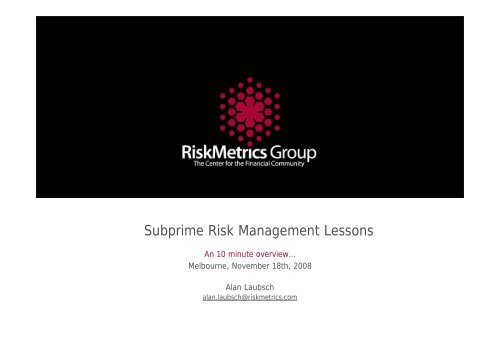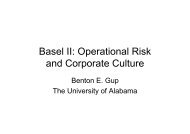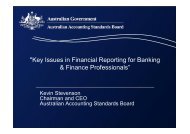Subprime risk management lessons
Subprime risk management lessons
Subprime risk management lessons
- No tags were found...
You also want an ePaper? Increase the reach of your titles
YUMPU automatically turns print PDFs into web optimized ePapers that Google loves.
<strong>Subprime</strong> Risk Management LessonsAn 10 minute overview…Melbourne, November 18th, 2008Alan Laubschalan.laubsch@<strong>risk</strong>metrics.com
The <strong>Subprime</strong> Risk Management FailuresThe subprime crisis represented a colossal <strong>risk</strong> <strong>management</strong> failure formany organizationsAs of Oct ’08, $670bn+ credit losses since ‘07; $1-1.5tn potential industry lossesCommonly cited systemic reasons include excess leverage, illiquidity, contagionFailure of credit rating agencies, and too much reliance on ratingsFailures in <strong>risk</strong> measurement and monitoring, concentration analysis, stress testingMajor organizational and cultural issuesWas the U.S. <strong>Subprime</strong> incident a “Black Swan,” an unforecastableextreme tail event?In fact, many analysts (including RiskMetrics CFRA) gave early warnings about the US housingbubble burst, and a number of firms positioned themselves to profit from this <strong>risk</strong>Robert Shiller: “There was a failure to communicate and a failure to put all thisinformation together and act on it in a systematic way” Source: Portfolio.com, “WorldAccording to Robert Shiller,” by Lloyd Grovewww.<strong>risk</strong>metrics.com 2
Importance of Enterprise Risk ManagementFirms with strong enterprise <strong>risk</strong> <strong>management</strong> cultures excelled,while organizations where <strong>risk</strong> is managed in silos failedOne thing is clear: the hardest hit banks, from Merrill Lynch to Citigroup, shared a siloedapproach to <strong>risk</strong>, with insufficient communication among <strong>risk</strong>, finance, andoperations. – Source: CFO.com, “Missing Pieces” by Avital Louria Hahn, March 2008The industry is recognising that firms that have skirted subprime disaster owe theirsuccess in part to robust <strong>risk</strong> <strong>management</strong> programmes. Among the regulators’conclusions are that firms with a comprehensive approach to <strong>risk</strong> <strong>management</strong>,where assessment of the exposure to <strong>risk</strong> is integrated throughout the organisationand where there is effective sharing of information, have dealt more successfullywith the credit crunch and disappearing liquidity. Source: FT.com, All minds focus on the urgentissue of <strong>risk</strong>, Beagan WilcoxRisk managers need to be perceived like good goalkeepers: always in the game andoccasionally absolutely at the heart of it, like in a penalty shoot-out. Source: Economist.com,Confessions of a Risk Managerwww.<strong>risk</strong>metrics.com 3
Bear Stearns High Grade Structured Credit StrategiesFundBear Stearn’s High Grade Structured Credit Strategies Fund, managed by RalphCioffi imploded in May 2007, wiping out investors’ capital (over $1.7bn)Investors up 46.8% from Oct ‘03 to Mar '07 w/ 30+ months of consecutive positivereturns. Strategy was to buy high grade subprime CDO tranches, and use leverage ofup to 20x to extract returns from positive carry (Short ABX “hedge” put on late 2006resulted in the fund’s first loss when ABX rallied in March after a sharp drop in Feb).Rating Agencies assigned high ratings due to low historical defaults (… in a rising UShousing market!)Warning signs – extremely high autocorrelation of returns (Box-Ljung test p=10 -15 )point to illiquidity and potential valuation issues.HFR Database Returns Analysis of 165 fixed income funds with data from October 2003 through February 2007-25th percentile p-value 41%-50th percentile p-value 9%-75th percentile p-value 0.8%Outliers … five funds with p-values smaller than 10-7:-Bear Stearns High-Grade Structured Credit (10-15) closed in June-Galena Street (10-7) closed in JulySource: Chris Finger, “A <strong>Subprime</strong>r on Risk,” August ’07 RiskMetrics Research Monthlywww.<strong>risk</strong>metrics.com 4
Lessons for Investors in Bear’s Funds1. Realized HF returns are NOT a good measure of <strong>risk</strong>. Need to understandwhat’s generating return. In fact, persistent positive returns with highautocorrelation are a warning sign2. Demand full <strong>risk</strong> transparency and understand what’s true alpha and what’salternative beta (e.g., carry generated through credit, term, fx, vol, etc.)3. Avoid Illiquid Assets + Leverage + Short Gamma (or accelerating losses)Short Gamma vs Linear positionProfitMarket downMarket upLosswww.<strong>risk</strong>metrics.com 5
Leveraged Credit Strategies & ContagionLevered L/S credit strategies got crushed with contagion… short gammaMorgan Stanley: $2bn short subprime, $14bn long AAA subprime paperPeleton Partners: $2bn ABS fund held $17bn AAA prime, short $6bn BB & lower subprime paperPure leveraged short subprime bets performed extremely well… long gammaLimited downside, huge upside potential: e.g., a 10x leveraged subprime strategy might have a 20% annualdownside (10x200bps) but a 1000% upsideWinners included funds that entered short subprime positions in 2006 Paulson, Corriente, Lahde, Hayman…“We were saying that there were going to be $1 trillion in loans in trouble,'' Bass says. ``That hadreally never happened before. You had to have an imagination to believe us….”Interesting presentation,'' Bass says the firm's chief <strong>risk</strong> officer said into his ear, his arm drapedacross Bass's shoulders. ``God, I hope you're wrong.'' –Kyle Bass, Hayman Capital onBloomberg NewsWhile some banks put on subprime hedges to limit their losses, banks arestructurally leveraged long credit. Basel 2 rules only require banks to put aside0.56% regulatory capital for AAA securities.www.<strong>risk</strong>metrics.com 6
Did VaR forecast the U.S. <strong>Subprime</strong> crisis?120.0%100.0%80.0%RM 2006 99% VaR bands vs 2006-1 AAA spreadOne major outlier, a 12 sdmove on Feb 23 '07, theday after the $10.5bnHSBC loss announcement60.0%40.0%Spread Change20.0%0.0%-20.0%-40.0%-60.0%-80.0%300%+ increase in volfrom Dec 12 to 21 '06357% vol spikeon Feb 23 '07Backtesting summary:2.4% upside excessions0.81% downside excessions-100.0%7/19/20068/19/20069/19/200610/19/200611/19/200612/19/20061/19/20072/19/20073/19/20074/19/20075/19/20076/19/20077/19/20078/19/20079/19/200710/19/200711/19/200712/19/20071/19/20082/19/20083/19/20084/19/20085/19/20086/19/2008Datewww.<strong>risk</strong>metrics.com 7
Responsive VaR estimators provided ample time tohedge…'2006-1 AAA'Absolute Spread Levels450400350300250200150100500Feb 23 '07, first majoroutlier, 350% vol increasein 1 day, 12sd moveThe first tremor(vol up 300% Dec 12-21)June 07, ML triesto liquidate Bear<strong>Subprime</strong> CDO's1/19/20063/19/20065/19/20067/19/20069/19/200611/19/20061/19/20073/19/20075/19/20077/19/20079/19/200711/19/20071/19/20083/19/20085/19/2008www.<strong>risk</strong>metrics.com 8
No Shortage Of Hypothetical Stress Tests To ConsiderGaveKal European Divergence ScenarioItaly’s continues to have budget deficits, ballooning debt, and eventually exits EURReal estate & construction slowdown in Spain, Portugal, GreeceRoubini U.S. Credit Contagion & Recession<strong>Subprime</strong> to Prime Contageon (2/3 of all ’06-’07 mortgages had <strong>risk</strong>y features)Muni selloffs & defaults (lower fees from developers and house taxes, fixed expenses)U.S. consumer slowdownCorporate Bond Defaults increase. Current avg: .6%’; LT avg: 3.8%; Recession: 10-15%Recovery rates: from 70% in benign environment to 30% during recessionShallow U.S. recessionary to longer / deeper recession (12-18 months), impact on global growthOil Spike (Iranian blockade; Saudi coup; natural disasters; war…)Market / FX shocks (Asian currency revaluation, $ bust/boom, EUR bust/boom...)Themes (BRIC growth, changing consumption patterns, baby boomer retirement...)Economic scenarios (inflationary bust, deflationary bust, inflationary boom, deflationary boom…)Avian Flu & other diseasesEnvironmental <strong>risk</strong>s (Tokyo earthquake, Storms, Tsunami, Oil spills, Chemical leaks...)Regulatory, Accounting, Fraud, Reputation, Liquidity...www.<strong>risk</strong>metrics.com 9
Integral Risk Management: All Quadrants“I”Individual“It”» Integrity» Ability to questionSubjective/Interior» Measures» DataObjective/Exterior» Culture of <strong>risk</strong><strong>management</strong>“We”Collective» Systems» Processes» Policies» Organization“Its”» See Ken Wilber, “A Theory of Everything”www.<strong>risk</strong>metrics.com 10
Levels: 3 Stages of Risk Management1. Pre-conventional: PrimalEmphasis on returnRisk taking driven by gut instinct and emotions: subjective view of <strong>risk</strong>Actions and thinking dominated by principalsFocused on pieces (positions), not the whole (portfolio)2. Conventional: Rules BasedClassification of <strong>risk</strong>s (operational, market, credit, liquidity, etc.)Implementation of standardized <strong>risk</strong> measuresRisk controlled with policies, procedures, and limitsHierarchical organization with clearly defined roles, including independent <strong>risk</strong> <strong>management</strong> functionFocus on quantifying, controlling, and minimizing <strong>risk</strong>: objective view of <strong>risk</strong>3. Post Conventional: IntegralProactive culture of <strong>risk</strong> <strong>management</strong> throughout the organizationConstant engagement and discussion about <strong>risk</strong>Harness intelligence both within and outside the organizationRisk viewed as both danger and opportunityEnterprise & portfolio perspective, not just position levelFlex flow, constantly evolving and improvingBlend of art and science: subjective + objectivewww.<strong>risk</strong>metrics.com 11
Summary RecommendationsRisk needs to be managed at the enterprise level, not silosGrow a pervasive <strong>risk</strong> <strong>management</strong> culture, and challenge all toidentify and communicate potential <strong>risk</strong>s & scenariosPay attention to early warning signs, qualitative andquantitativeDon’t reduce <strong>risk</strong> <strong>management</strong> to just numbers. Keep in mind allquadrants: I, WE, IT, ITSwww.<strong>risk</strong>metrics.com 12
Questions?www.<strong>risk</strong>metrics.comasia@<strong>risk</strong>metrics.comTel. +65 6826 9333www.<strong>risk</strong>metrics.com 13
RiskMetrics Group: One Company/Multiple CapabilitiesWe help investors better understand and manage <strong>risk</strong> across a broad spectrumRiskMetrics Group offers industry-leading products and services in the disciplines of <strong>risk</strong><strong>management</strong>, corporate governance and financial research & analysisRiskMetrics –a leading provider of quantitative <strong>risk</strong> <strong>management</strong> and portfolio analyticsISS Governance Services –a leading provider of corporate governance and proxy votingservicesFinancial Research & Analysis –a leading provider of forensic accounting, legal andregulatory researchwww.<strong>risk</strong>metrics.com 14
Addressing a Broad Spectrum of RiskRiskMetrics Group views <strong>risk</strong>through a wide lens, enablingclients to make more informeddecisions based upon multiplepoints of <strong>risk</strong> insight and amore complete <strong>risk</strong><strong>management</strong> solution.RiskManagerProxy AnalysisAccounting ResearchCreditManagerProxy VotingLegal ResearchRiskRREVMeasurementM&A ResearchDataGlobalServicesProxyES&G Distribution ResearchPortfolio ReportingData Securities & Analytics ClassAction ServicesRiskMetrics Groupwww.<strong>risk</strong>metrics.com 15









